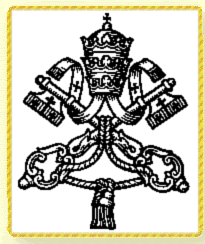Here are a few excerpts:
POST-SYNODAL
APOSTOLIC EXHORTATION
SACRAMENTUM CARITATIS
OF THE HOLY FATHER
BENEDICT XVI
TO THE BISHOPS, CLERGY,
CONSECRATED PERSONS
AND THE LAY FAITHFUL
ON THE EUCHARIST
AS THE SOURCE AND SUMMIT
OF THE CHURCH'S LIFE AND MISSION
INTRODUCTION
1. The sacrament of charity (1), the Holy Eucharist is the gift that Jesus Christ makes of himself, thus revealing to us God's infinite love for every man and woman. This wondrous sacrament makes manifest that "greater" love which led him to "lay down his life for his friends" (Jn 15:13). Jesus did indeed love them "to the end" (Jn 13:1). In those words the Evangelist introduces Christ's act of immense humility: before dying for us on the Cross, he tied a towel around himself and washed the feet of his disciples. In the same way, Jesus continues, in the sacrament of the Eucharist, to love us "to the end," even to offering us his body and his blood. What amazement must the Apostles have felt in witnessing what the Lord did and said during that Supper! What wonder must the eucharistic mystery also awaken in our own hearts!(...)
The Latin language
62. None of the above observations should cast doubt upon the importance of such large-scale liturgies. I am thinking here particularly of celebrations at international gatherings, which nowadays are held with greater frequency. The most should be made of these occasions. In order to express more clearly the unity and universality of the Church, I wish to endorse the proposal made by the Synod of Bishops, in harmony with the directives of the Second Vatican Council, (182) that, with the exception of the readings, the homily and the prayer of the faithful, such liturgies could be celebrated in Latin. Similarly, the better-known prayers (183) of the Church's tradition should be recited in Latin and, if possible, selections of Gregorian chant should be sung. Speaking more generally, I ask that future priests, from their time in the seminary, receive the preparation needed to understand and to celebrate Mass in Latin, and also to use Latin texts and execute Gregorian chant; nor should we forget that the faithful can be taught to recite the more common prayers in Latin, and also to sing parts of the liturgy to Gregorian chant. (184)(...)
The location of the tabernacle
69. In considering the importance of eucharistic reservation and adoration, and reverence for the sacrament of Christ's sacrifice, the Synod of Bishops also discussed the question of the proper placement of the tabernacle in our churches. (196) The correct positioning of the tabernacle contributes to the recognition of Christ's real presence in the Blessed Sacrament. Therefore, the place where the eucharistic species are reserved, marked by a sanctuary lamp, should be readily visible to everyone entering the church. It is therefore necessary to take into account the building's architecture: in churches which do not have a Blessed Sacrament chapel, and where the high altar with its tabernacle is still in place, it is appropriate to continue to use this structure for the reservation and adoration of the Eucharist, taking care not to place the celebrant's chair in front of it. In new churches, it is good to position the Blessed Sacrament chapel close to the sanctuary; where this is not possible, it is preferable to locate the tabernacle in the sanctuary, in a sufficiently elevated place, at the centre of the apse area, or in another place where it will be equally conspicuous. Attention to these considerations will lend dignity to the tabernacle, which must always be cared for, also from an artistic standpoint. Obviously it is necessary to follow the provisions of the General Instruction of the Roman Missal in this regard. (197) In any event, final judgment on these matters belongs to the Diocesan Bishop.
Read the complete document here.










No comments:
Post a Comment